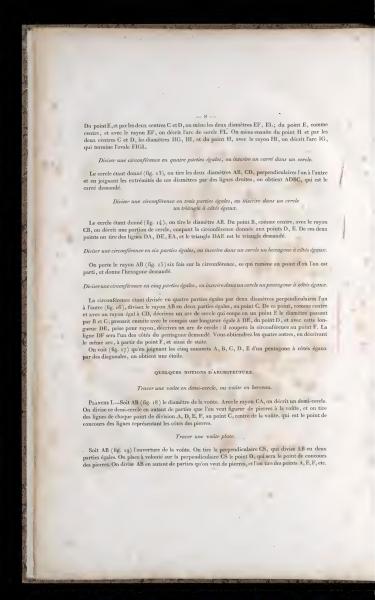The text provides instructions on dividing a circle into equal parts and drawing geometric shapes like squares, triangles, hexagons, and pentagons within a circle. It explains the method for inscribing these shapes and includes a section on basic architectural concepts for drawing arches and vaults. Techniques include the use of diameters, radii, and arcs to complete these geometric constructions.
From point E, and through the two centers C and D, draw the two diameters EF, EL; from point E, as the center, and with the radius EF, draw the arc of the circle FL. Then, from point H and through the two centers C and D, draw the diameters HG, HI, and from point H, with the radius HI, draw the arc IG, which completes the oval FIGL.
Dividing a circumference into four equal parts or inscribing a square in a circle.
With a given circle (fig. 13), draw the two diameters AB, CD, perpendicular to each other, and by joining the ends of these diameters with straight lines, you obtain ADBC, which is the desired square.
Dividing a circumference into three equal parts or inscribing a triangle with equal sides in a circle.
With a given circle (fig. 14), draw the diameter AB. From point B, as the center, with the radius CB, draw a portion of the circle, cutting the given circumference at points D, E. From these two points, draw lines DA, DE, EA, and the triangle DAE is the desired triangle.
Dividing a circumference into six equal parts or inscribing a hexagon with equal sides in a circle.
Project the radius AB (fig. 15) six times around the circumference, bringing you back to the starting point, and forming the desired hexagon.
Dividing a circumference into five equal parts or inscribing a pentagon with equal sides in a circle.
Having divided the circumference into four equal parts by two perpendicular diameters (fig. 16), divide the radius AB into two equal parts at point C. From this point, as the center, and with a radius equal to CD, draw an arc that intersects the diameter BC at point E; then, using this first length DE with a compass, draw another arc extending from point D. This arc will cut the circumference at point F. The line DF will be one of the sides of the requested pentagon. Obtain the remaining four similarly, drawing from point F onward.
It is demonstrated (fig. 17) that joining the five vertices A, B, C, D, and E of an equilateral pentagon by diagonals produces a star.
Some notions of architecture.
Drawing a semi-circular arch, or barrel vault.
Plate I.—Let AB (fig. 18) be the diameter of the vault. With the radius CA, draw a semicircle. Divide this semicircle into as many parts as desired for representing stone courses in the vault, and draw lines from each division point A, D, E, F, to point C, the vault’s center, which serves as the convergence point of the lines representing the stone sides.
Drawing a flat arch.
—Let AB (fig. 19) be the opening of the arch. Draw the perpendicular CS, which divides AB into two equal parts. Place point D freely on the perpendicular CS, which will serve as the convergence point of the stones. Divide AB into as many parts as desired for the stones, and draw from points A, E, F, etc.
Translation Notes:
- "Voûte" translates to "arch" or "vault," often referring to architectural elements.
- "Le compas" is translated as "the compass," a drawing tool used for circles or arcs.
